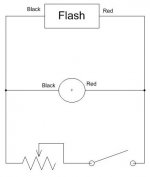y4m4
Cal Graham
Got an old auto flash that isn't of much use to you anymore? Wanna manually control its output? Good news it will cost less than $10 at RadioShack! It turns out that if you put a variable resistor(potentiometer) in place of the little light-sensing cell you can manually control practically any flash.
So to do this you have to open the flash up. You'll need some small screw drivers and will probably need to take off a decal or two. Once its open cut the wires that connect to the photo cell. Make sure you leave enough wire on each side to strip and solder.
If you want to eliminate the photocell all together and go full manual just hook the potentiometer in place of it. On my potentiometer you use the left and middle terminals. Test it out! You'll need a potentiometer that goes to about 200k ohms if you are planning on taking the cell out or use a switch to bypass the potentiometer.
Now the way I'm doing it is as follows. I am hooking the potentiometer and photo cell in parrallel with a switch so I can have full use of my original auto modes. Take a look at the attached image for circuit diagram. The other plus is that I can have full power without buying another potentiometer, mine is only 100k ohms, not enough to fire the flash at full.
The way my vesion works is that you need to have your flash set on 'Manual,' or full power with the switch in the On position. Now you can control the output. Turn the switch Off and it reverts to its original factory settings.
I recommend you mock this up using alligator clips to make sure it works on your particular flash before soldering anything.
The idea came from this guy who has a some great information on his site about the Vivitar 283: http://www.krebsmicro.com/VIV283/index.html I'm not sure why he has a small capacitor connected in his setup but mine works fine without it.
Take it easy on me and my symbols. I'm a Mechanical Engineering Technology student so I have little training in electronics(or anything for that matter since I'm jsut finishing up my second year).
Please, be careful! Flashes have pretty large capacitors and can hurt you. Make sure you discharge your flash prior to taking it apart and remove the batteries. Please don't blame me if you mess anything up or hurt yourself. I didn't make you take your flash apart.
Now that you have a full manual flash make sure you check out the Strobist site for some stellar information.(No affiliation!)
So to do this you have to open the flash up. You'll need some small screw drivers and will probably need to take off a decal or two. Once its open cut the wires that connect to the photo cell. Make sure you leave enough wire on each side to strip and solder.
If you want to eliminate the photocell all together and go full manual just hook the potentiometer in place of it. On my potentiometer you use the left and middle terminals. Test it out! You'll need a potentiometer that goes to about 200k ohms if you are planning on taking the cell out or use a switch to bypass the potentiometer.
Now the way I'm doing it is as follows. I am hooking the potentiometer and photo cell in parrallel with a switch so I can have full use of my original auto modes. Take a look at the attached image for circuit diagram. The other plus is that I can have full power without buying another potentiometer, mine is only 100k ohms, not enough to fire the flash at full.
The way my vesion works is that you need to have your flash set on 'Manual,' or full power with the switch in the On position. Now you can control the output. Turn the switch Off and it reverts to its original factory settings.
I recommend you mock this up using alligator clips to make sure it works on your particular flash before soldering anything.
The idea came from this guy who has a some great information on his site about the Vivitar 283: http://www.krebsmicro.com/VIV283/index.html I'm not sure why he has a small capacitor connected in his setup but mine works fine without it.
Take it easy on me and my symbols. I'm a Mechanical Engineering Technology student so I have little training in electronics(or anything for that matter since I'm jsut finishing up my second year).
Please, be careful! Flashes have pretty large capacitors and can hurt you. Make sure you discharge your flash prior to taking it apart and remove the batteries. Please don't blame me if you mess anything up or hurt yourself. I didn't make you take your flash apart.
Now that you have a full manual flash make sure you check out the Strobist site for some stellar information.(No affiliation!)


